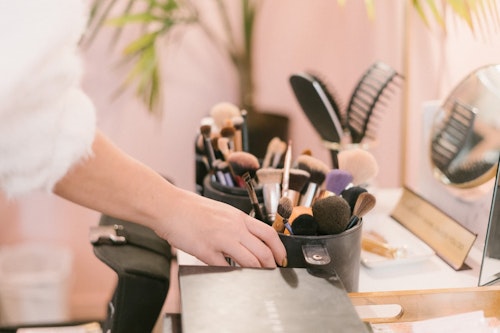Five toxic ingredients to watch out for in makeup and skincare products
Written By
Joy EmehWriter| Editor| Content Strategist

Everyone wants to feel and look good, and this desire for beauty increases by the day, making us spend more money on beauty products.
Unfortunately, some of these products contain some ingredients, chemicals, or irritants harmful to the skin and health in the short or long run.
Some of them have carcinogenic properties and can even disrupt the normal functioning of the endocrine system.
The United States is rated the greatest cosmetic market globally, with statistics showing an annual growth rate of 5.5% in 2018 and a growth of 5.25% in 2019. This shows that consumers have been spending more on cosmetics than they use to in the past.
The fact is that most governments are not strict with regulating cosmetics, not as much as they regulate other items like food and drugs.
However, we forget that cosmetics are also things we feed our body with. Maybe we do not ingest them orally/directly as we do food and drugs, but our body still ingests them as they can get absorbed through the skin pores.
Aside from the danger some synthetic chemicals pose to the skin; they might also threaten an individual's general health and well-being.
Thus, there is a great need for governments to place more strict regulations on cosmetics and skincare products. There should be pre-product approval even before they hit the markets.
Here are five of such ingredients you should check out before you purchase your beauty products.
Parabens
Parabens are typically known to cause skin irritations. Unfortunately, you will find them in various beauty products such as skin moisturizers, makeup, shampoo, shaving gel etc.
They are synthetic chemicals that serve as preservatives for beverages, foods and some pharmaceutical products.
The American Chemical Society stated that parabens are found in 85% of beauty, health and personal care products and are commonly listed under propyl-, ethyl-, butyl-, isopropyl- and methyl- parabens.
While this ingredient might seem like a superhero, prolonging the life of your products, it turns out it tends to mar you.
Parabens have been listed as endocrine disruptors, which means they can alter the body hormones.
Parabens have a chemical structure similar to the oestrogen hormone. This makes it possible for them to mimic the oestrogen hormone, thus predisposing one to different problems such as acne, male breast growth, decreased sperm count, and even neurological disorders.
It has also been linked to different types of cancer such as breast and skin cancer, allergic reactions and other reproductive problems.
Formaldehyde
Formaldehyde is a colourless, flammable gas with many industrial applications. Its primary purpose is to serve as a preservative.
When dissolved in water, it gives formalin used as a disinfectant and in preserving biological specimens. Formalin is commonly used in the morgue for preserving corpses.
Formaldehyde is also found in beauty and skincare products such as makeup creams, nail polish, deodorants, body washes, eye shadows, conditioners etc.
The aim is to prevent the growth of bacteria in these products; however, studies have shown the chemical to be a human carcinogen and have been linked to certain types of cancers.
While short term exposure to formaldehyde can cause difficulty in breathing, skin irritation, burning nose and watery eyes, long term use or exposure can cause hair loss, cancer and immune system compromise.
Hydroquinone
Hydroquinone is one of the most controversial skincare ingredients. It is a chemical compound discovered as far back as the early 1800s.
It is said to be effective in lightening dark spots and works by interacting with cells that produce melanin to decrease pigment production.
It is found in skin-lightening lotions, cleansers, serums and moisturizers and is even used in combination with other acne treatment products like Retin-A.
While it has shown to be useful in lightening dark spots, giving a brighter skin tone and treating melasma, there is still its side effects.
Hydroquinone which is regarded as a bleaching chemical can cause skin discolouration. It can predispose consumers to ochronosis, with irreversible black, red and green lesions.
Some skin lightened contain mercury which is toxic to children, pregnant women and even adults.
Sodium lauryl sulfate (SLS)
Sodium lauryl sulfate is a common ingredient in face wash, toothpaste, mouthwash, shampoo and face foundations.
However, it has been enlisted in the Environmental Working Group's Skin Deep Cosmetic Safety Database as a "moderate hazard" as it has been linked to cancer, organ toxicity and neurotoxicity.
SLS makes shampoo and some other body products foam, but it has shown the potentials of having harmful side effects, especially when applied to the skin.
It is a known skin, eye, mouth and lung irritant. They also tend to clog skin pores, thus, contributing to acne (particularly cystic acne) around the mouth and chin.
Phthalates
Phthalates are chemical ingredients that soften plastics and make them flexible. They are also called plasticizers.
They are commonly found in cosmetic and beauty products like hair spray, nail polish, soap, shampoo, perfumes, deodorants and skin moisturizers.
They are known to be endocrine disruptors and can predispose one to breast cancer. It can lead to early breast development in girls and reproductive problems in both males and females.
It is notable to say that this product has been banned from cosmetics in the European Union but is still prevalent in U.S. products. Unfortunately, it is not always disclosed in every product as it is mostly added as an additive to fragrances.
You should look out for phthalate, DBP, DEP, DEHP and fragrance in the product label and ensure that none is listed before purchasing.
While it is okay to opt for products that will enhance your beauty, you should go about it with caution.
Some of the beauty products will only make you look good for a while but could cause you life-long damages because of some of the ingredients contained in them.